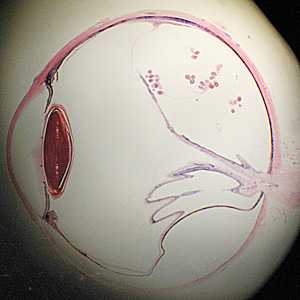
Case #278 - June, 2010
DPDx is moving! Along with the all of the laboratories within the Division of Parasitic Diseases and Malaria at the CDC! We want to take this opportunity to let you know that although actual specimen receiving and testing will be temporarily interrupted for about a week or two, DPDx will continue to provide telediagnosis assistance via the internet.
This leads us to the second case for this month. While packing for the move, we discovered an interesting pathology slide labeled with only an accession number. Figure A shows the slide and Figure B shows the specimen using a dissecting microscope. The slide was observed under a compound microscope for higher magnification; Figures C and E show areas captured at 40x, and Figures D and F at 200x. What is your diagnosis? Based on what criteria?

Figure A

Figure B

Figure C

Figure D

Figure E

Figure F
Case Answer
The slide showed a case of coenurosis which is caused by infection with the metacestode larval stage (coenurus) of Taenia multiceps or T. serialis. The presence of protoscoleces ruled-out sparganosis (caused by Spirometra spp.). The presence of more than one protoscolex within the cyst ruled-out cysticercosis (caused by Taenia solium). The thin cyst wall lacking a laminated layer ruled-out echinococcosis (caused by Echinococcus sp.). Coenuri may be found in most tissue types, but those of T. multiceps have a predilection for the central nervous system and eye; those of T. serialis are usually found in subcutaneous tissue.
More on: Coenurosis
Images presented in the monthly case studies are from specimens submitted for diagnosis or archiving. On rare occasions, clinical histories given may be partly fictitious.
DPDx is an education resource designed for health professionals and laboratory scientists. For an overview including prevention and control visit www.cdc.gov/parasites/.
- Page last reviewed: August 24, 2016
- Page last updated: August 24, 2016
- Content source:
- Global Health – Division of Parasitic Diseases and Malaria
- Notice: Linking to a non-federal site does not constitute an endorsement by HHS, CDC or any of its employees of the sponsors or the information and products presented on the site.
- Maintained By:


 ShareCompartir
ShareCompartir